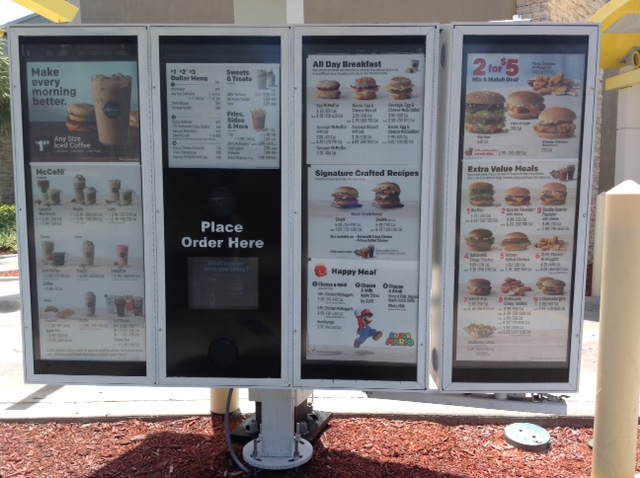Imagine a world where
-
- Fast-food restaurants provide the population with hot, inexpensive meals,
- No one considers fast food to be unhealthy,
- Blacks are not allowed to eat at white restaurants or stay at white motels,
- Race relations are fine on the surface, but tensions loom below, and
- A violent, Marxist political party serves free breakfasts to Black school children.

What is a franchise? Franchising is an American innovation. Its roots trace back to the Catholic Church in the Middle Ages. Coca-Cola adapted the concept to bottling plants located in towns across the nation. Major corporations were able to assign liability to franchisees and even local governments. The success of McDonald’s resulted from its mastery of the franchising system. In my youth Burger Chef served better food but with a less successful business plan. My high-school band stopped there for burgers as it returned from away football games. McDonald’s set the business standard for chains like KFC, Taco Bell, and Dunkin’ Donuts.

Black ferment in 50s and 60s ushered in a new era in America. Supreme Court decisions like Brown v Board of Education rocked the nation. It laid the groundwork for monumental change in society. Freedom riders and sit-ins at lunch counters were parts of a growing movement. The I-have-a-dream speech by Martin Luther King was a highlight of the movement. The Civil Rights Act of 1964 prohibited discrimination throughout the land. The law did not result in immediate change in the South. This atmosphere led McDonald’s into Black communities across the country. Civil unrest gripped the nation. I remember hurrying home after school when Harvey Gantt enrolled in college in my home town. We were on virtual lockdown for a week anticipating a confrontation of the races. No violence erupted, and we went back to life as normal.
Black capitalism was the answer to the racial divide in the country. The ideal model was a store set in a Black neighborhood. It provided jobs to Black employees working for Black ownership. White owners of outlets in the Black community created tension. Protests began with burger boycotts. Sometimes the situation grew more intense. Looting and violence occurred on occasion in major cities. Reinvestment of profits back into the community was the goal. Too often proceeds failed to meet expectations. Particular difficulties arose in Atlanta, Cleveland, Philadelphia, and Portland.
Serving inner cities was the goal. To McDonald’s, Blacks represented a growth opportunity. The chain offered Black consumers meals that they could afford. Most locations featured window walk-ups. A few round, metal picnic tables outside the store provided all the seating available. The operations featured speed, convenience, and consistency of quality. The 50s and 60s were the era of the 15-cent hamburger. For an extra nickel we could upgrade it to a cheeseburger. Add a small order of fries and a Coke or milk shake for a satisfying meal costing less than a dollar! It was the era before Big Macs and supersizing. The amount of food needed at a meal was very different from today’s expectations.
Fast food as an unhealthy option did not become apparent until the 1980s. In my youth fast food did not have the seedy reputation it has today. Their restaurants did not anchor food swamps. They offered quality food in a clean environment. Larger portion sizes with more calories led to condemnation by health professionals. Replacement of mom-and-pop restaurants led to greater dependence on fast food. A marketing campaign prompted Morgan Spurlock to question the need for supersizing. It was becoming clear that fast-food culture was replacing traditional soul-food fare. White health professionals had little use for many non-traditional diets. Black health professionals attempted to reclaim the higher ground.
A fair share of the pie was the quest of Black entrepreneurs and community leaders. Local owners plowed money back into the neighborhood but as marketing device. Some individuals resented the amount of money going to corporate headquarters. The relationship between the corporation and these communities was about more than burgers. Most of us have strong opinions about fast food in general and McDonald’s in particular. We may also may have trouble projecting our thoughts back to a previous era. Such is the value of an accurate rendering of history. Food historians provide an understanding of how relationships with foods are changing. Anyone interested in how fast food and racial inequities intertwine will enjoy Franchise.
A note on the author is of importance here. Marica Chatelain is a professor of history and African American Studies. As a Black historian at Georgetown she brings authenticity to this subject. Franchise is not so much about the burgers. It focuses on the interface between a very successful company and low-income communities. The author provides us with a complex description of that interaction. Her skillful balance treads the fine line between exploitation and economic opportunity. Avoid this book if you are unwilling to explore new perspectives on fast food or race relations.
Next week: Confessions of a fast-food lover

One thought on “Franchise: The Golden Arches in Black America”